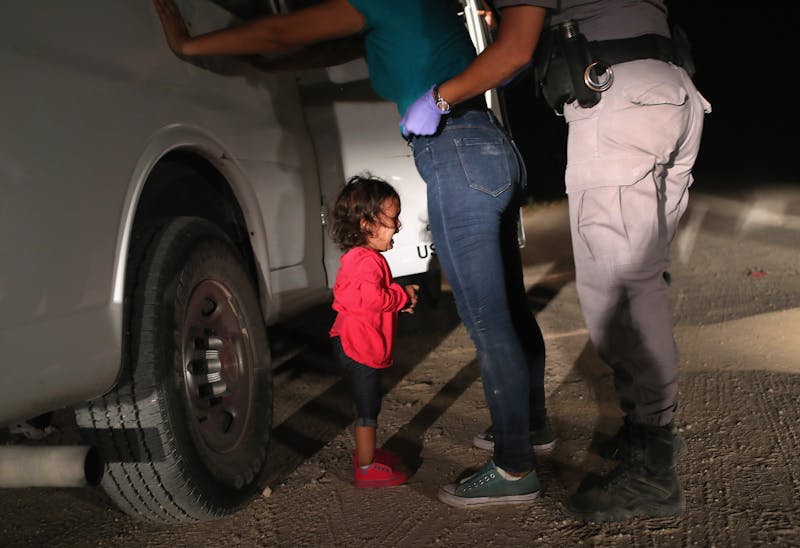The outcry that has greeted Donald Trump’s initiative to separate immigrant children from their parents at the U.S. border has been propelled by a series of images, recordings, and reports in the media. We have seen photographs of wailing children, in cages or all alone; we have heard them cry. Their terror and sadness is overwhelming to witness. Though the Ann Coulters of this world claim that children can “act” on screen to manipulate the public into opposing Trump’s policy, this is not true. A four-year-old cannot act.
The power of this kind of media lies in that authenticity. When John Moore took his now-viral photographs of a two-year-old girl at the U.S. border, “he understood at once that they were the photos he had been waiting for—for hours, if not years,” The Washington Post reported. The baby would become an image that changed something—maybe not for her but perhaps for others, if not the underlying policy, the way Americans viewed their government. It is natural for adults to want to protect innocent and helpless children, particularly those who have been made helpless by powerful political actors in the White House. Their cries represent a rare moment of genuine emotion in the shiny and false theater of American politics.
But the ethics of a “poster child” campaign are not as straightforward as many in the media are making out. Sharing a photograph or a link creates awareness and churns outrage, but it also defines the debate in ways that obscure the root problem. The immediate question is the fate of these children; the immediate enemy is a depraved White House. The larger challenge, however, requires a compassion that is broader than what a single child can invoke.
Poster children have proliferated in media coverage of political crises in recent years. Little kids in Iraq (Samar Hassan, 5, living), in Syria (Omran Daqneesh, 5, living), and on migration routes through Europe (Alan Kurdi, 3, dead) have become potent symbols that have produced reactions in the West that images of adults have not. This type of coverage has long roots, from Nick Ut’s famous image of nine-year-old Phan Thi Kim Phuc running along a road after being burned by napalm, to the starving children of Ethiopia in the 1980s.
These images connect to the long history of western philanthropy for children. The charity sector, for example, abundantly uses small children to provoke bourgeois pity. In the early 1980s, a campaign by the U.K.’s Disasters Emergency Committee drew attention to the famine in East Africa by using a photograph of two emaciated children eating, under the headline “THEIR LAST MEAL.” Donors gave $23 million in response.

These poster children present a paradox: They are real, so is their suffering—but they have also been chosen to represent a suffering that is shared by many others. A stark example is the “sponsor a child” style of philanthropy, where a charity like Save the Children pairs the donor with an individual recipient of your funds. The donor can even choose the child from a list of photographs. In Bleak House, Dickens caricatured this kind of humanitarianism in the character of Mrs. Jellyby, who obsessively advocates for a faraway population but neglects to care for her own kids. His critique was that the Jellybys of the world sometimes commit the sin of simony, meaning that they trade in sacred and spiritual materials for their own emotional profit.
There are several political repercussions of allowing a single child to represent a crisis. The first is that the child herself, literally voiceless in the case of Moore’s photograph, ceases to be an individual. She instead becomes a blank canvas upon which adults project their anxieties and fears. The second is that it obscures the suffering of others—particularly adults. Moore’s photograph captures this young migrant’s isolation so well that it hurts; but, by definition, it leaves out the faces of the rest of her family. It reduces a crisis about human beings of all ages and stages of life to a single image of total vulnerability.
Behind the American response to these images of children lurks an uncomfortable truth: The white majority in this country perceives children of color differently than they perceive adults, in what we might call the visual rhetoric of victimhood. This crisis is happening to babies, toddlers, teenagers, parents, and elderly adults; but the only images that can make America care about its inhumane policy toward immigrants at its borders, the only images that can cause a Republican like Laura Bush to speak on behalf of these foreigners, are photographs of children.
Just as in the advertisement seeking funds for the famine in Ethiopia, these are not false images: They depict real pain. But justice still lacks for a suffering child if that child’s total helplessness is the only thing that can move people. When people pity a baby who has no political agency, the baby becomes an image through which people express anxieties about their government in a different way than if they had to respond to an adult’s autonomous speech. It’s not a conversation.
Perhaps the “poster child” media syndrome will always function as a catalytic stage. First, we see the baby; the baby’s cries then connect to some animal part of our hearts, which in turn activates the conscious parts of our minds. But, relying too much on the heart to do political work around immigration is like relying on baby polar bears to get people to care about climate change; it’s a limited strategy, and it limits our understanding. There’s an adage in social justice advocacy to remind us that victims shouldn’t have to exhibit their trauma to gain respect and understanding: Exhibited suffering breeds empathy, but it turns the traumatized into a spectacle. Migrants at the U.S. border need agency, urgently. And to facilitate that Americans need to listen to what they have to say. An infant can scream, but she cannot speak.
